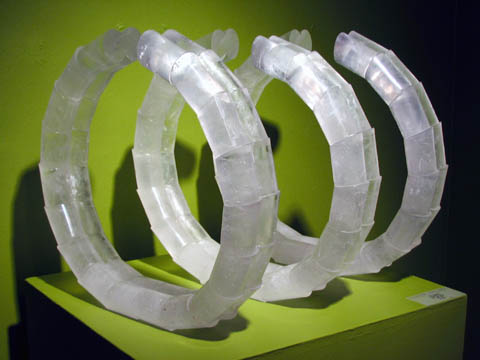GLASS QUARTERLY
Profile:
Trin Nguyen
by Richard Speer
With a conceptual bent tempered by an eye for beauty, Trinh Nguyen is a minimalist glass sculptor whose most recent commission resides in that most maximalist of American cities, Las Vegas. Nguyen’s story began 31 years ago, far from the lights of the Strip, in Can Tho, Vietnam. When he was six, his family fled the country, seeking political asylum in the United States. It was in Atlanta, Georgia, in kindergarten, that the young émigré first became aware of his talent for art, and in the years that followed he took up painting, the only artist in a family of physicians and pharmacists. In his sophomore year at the Parsons School of Art and Design, he left the second dimension for the third, majoring in sculpture, with an additional major in product design and a minor in art history.Since graduating from Parsons, Nguyen, who now lives and works in Brooklyn, has shown his glass work throughout the country, with one-person and group shows at Friesen Gallery in Seattle and Sun Valley, Idaho; D&A Fine Arts in Los Angeles; and various outings in New York, Philadelphia, and Boston. The Las Vegas commission is his latest and most ambitious project to date, a four-foot by four-foot glass-and-steel triptych in the lobby of the Red Rock Casino and Resort. The piece’s sheer size and weight (each of its three elements weighs 250 pounds) presented a host of engineering difficulties, primarily related to the connective joints and the challenges of grinding and polishing stainless steel. But transcending his media’s idiosyncrasies is integral to the commission’s overall purpose, which Nguyen sees as overcoming “the heaviness and coldness of the materials” by communicating an airiness and warmth as the glass and steel “cradle and embrace one another.”
The Las Vegas piece is part of the artist’s larger Shackle series, smaller incarnations of which have been exhibited recently in Seattle and Sun Valley. Incomplete circles comprised of cast glass segments, the works appear oddly vertebral, familiar yet foreign, pleasing the eye even as they vaguely unnerve the mind. The artist himself compares these organic forms to plant cells or crustacean life forms.
The series contrasts notably with another of Nguyen’s series, an etude of architectonic wall panels that riff on the relationship between translucence and opacity. Colored amber, gray, black, and a stunningly Bermuda blue, these panels engage interactively with light and are held together by caps and columns in matte-finish fabricated steel. Perhaps the most satisfying of these pieces is called Magenta Gradation and consists of twenty kiln-cast glass panels transitioning from clear to deep purple, with delicious, Chambord-colored marbling in between. The work illustrates the artist’s interest in mass production, serial repetition, and efficiency, which he traces to his product design work at Parsons. He aims to continue this line of exploration in future series, shows, and commissions, details of which he showcases on his website, TrinhNguyen.com.
Like many artists of his generation, Nguyen balances a familiarity with art history with a knack for pop culture. Speaking about his work and its influences, he harkens to Helen Frankenthaler and Mark Rothko’s color-field experiments in the 1960s and Donald Judd’s 1970s minimalism, then nonchalantly quotes an ironic passage from an episode of The Simpsons. It is this sort of winning eclecticism, coupled with a gift for inventive forms and a penchant for perfectionism in execution, that make Trinh Nguyen an artist to watch. Not to mention ambition. “What I hope for,” he tells Glass Quarterly, “is the recognition that all artists aspire to. Being in the Whitney Biennial and the MoMA collection is what I’m working towards.”
—A contributing critic to ARTnews and Art, Ltd., Richard Speer is the author of Matt Lamb: The Art of Success (John Wiley & Sons) and is visual arts critic at Willamette Week, the Pulitzer Prize-winning alternative weekly in Portland, Oregon. He has written about cultural matters for Newsweek, Salon, The Los Angeles Times, and Opera News.
